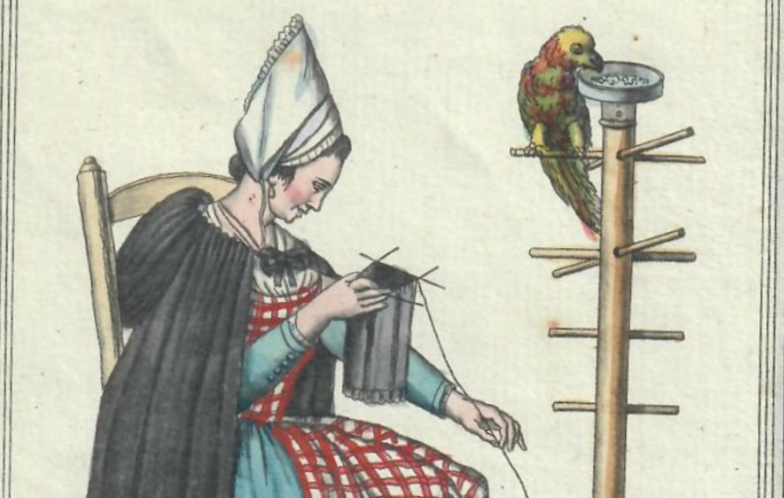
Historical textile and fashion prints for the TRC in Leiden
Over the last few months the TRC has acquired a number of antique prints that will be used to illustrate various mini- exhibitions (actual and digital) as well as publications (notably the Bloomsbury World Encyclopedia of Embroidery), as well as lectures and workshops on the themes of textiles, their production and use.
One of the late 18th century prints (TRC 2023.0004), for example, depicts a woman knitting with four knitting needles, while a cat plays with a ball of knitting yarn and a dog and a parrot look on. The print comes from Costumes de différents pays by the French encyclopaedist Jacques Grasset de Saint-Sauveur (1757-1810).

Costume print, France, from 'Costumes de différents pays' (c. 1797), by Jacques Grasset de Saint-Sauveur (1757-1810) (TRC 2023.0004).
Another group of prints depict various trades in late 17th century Amsterdam from the famous book by Jan Luyken (1649-1712) and his son Casper (1672-1708), called Spiegel van het Menselyk Bedryf (1694, Amsterdam).
The book was reprinted on various occasions in the 18th century. A number of the prints depict textile and related professions such as the wool sorter, weaver, tapestry seller, embroiderer (TRC 2023.0002), and rope maker.

Print of an embroiderer, from Jan Luyken's 'Spiegel van het Menselyk Bedryf' (Amsterdam 1694) (TRC 2023.0002).
Each print includes an image of the particular occupation, and above and below the print a moralistic poem. We hope to get the complete range of textile and related crafts prints as they provide a wealth of information about tools, equipment and working practices of pre-industrial Amsterdam and indeed elsewhere.
We have also recently acquired a number of French fashion plates from the 1850s and 1860s (most of them have a date just under the main image) that depict very fashionable women and children in the latest Parisian modes. These prints will be used for two mini-exhibitions, one will be about black silk bobbin lace (often known as Chantilly; TRC 2023.0374).
This type of lace was used for head coverings (lappets), shawls, as well as flounces on sleeves, bodices and skirts.

French fashion print, 1855, depicting two fashionable women wearing large crinolines (TRC 2023.0374).
The other mini-exhibition will be about false sleeves called engageantes, also shown in some of the prints. The TRC has various sets of engageantes dating from the latter half of the 19th century (such as TRC 2006.0132a-b).
So the prints will be very useful to show how these and other items were used in the 19th century.

Pair of engageantes, the Netherlands, mid-19th century (TRC 2006.0132a b).
There are also prints that depict dress and identity themes from various cultures around the world. Care has to be take with these as it is not always clear if the etcher/artist had actually seen the garments and how they were worn, or whether they were copied from other publications or indeed totally made up.
One example of this group of prints is called the “Femme Samoïede” (TRC 2023.0023), from Costumes de différents pays, by Jacques Grasset de Saint-Sauveur.

Costume print, "Femme Samoïede" ('Samoyedic woman'), from 'Costumes de différents pays' (c. 1797), by Jacques Grasset de Saint-Sauveur, France, late 18th century (TRC 2023.0023).
And why do we want actual copies of these prints rather than simply downloading them off the internet? Well, not everything is available in a high resolution form needed for publications and exhibitions. In addition, more and more people and institutes are requiring/demanding copyright fees and sometimes these prices are simply too high for most individuals or groups such as the TRC in Leiden. But apart from these somewhat prosaic arguments, let's be fair: it is wonderful to physically see and admire these early prints.
Text by Gillian Vogelsang-Eastwood
